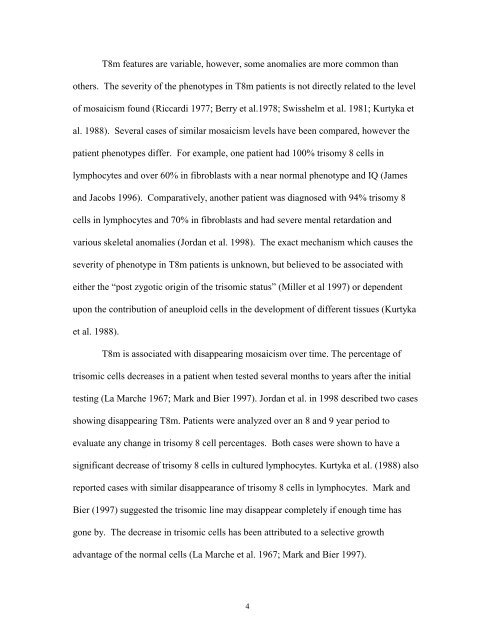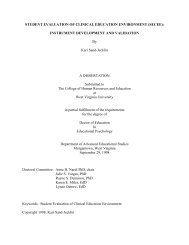TRISOMY 8 MOSAICISM: CELL CYCLE KINETICS AND ...
TRISOMY 8 MOSAICISM: CELL CYCLE KINETICS AND ...
TRISOMY 8 MOSAICISM: CELL CYCLE KINETICS AND ...
Create successful ePaper yourself
Turn your PDF publications into a flip-book with our unique Google optimized e-Paper software.
T8m features are variable, however, some anomalies are more common than<br />
others. The severity of the phenotypes in T8m patients is not directly related to the level<br />
of mosaicism found (Riccardi 1977; Berry et al.1978; Swisshelm et al. 1981; Kurtyka et<br />
al. 1988). Several cases of similar mosaicism levels have been compared, however the<br />
patient phenotypes differ. For example, one patient had 100% trisomy 8 cells in<br />
lymphocytes and over 60% in fibroblasts with a near normal phenotype and IQ (James<br />
and Jacobs 1996). Comparatively, another patient was diagnosed with 94% trisomy 8<br />
cells in lymphocytes and 70% in fibroblasts and had severe mental retardation and<br />
various skeletal anomalies (Jordan et al. 1998). The exact mechanism which causes the<br />
severity of phenotype in T8m patients is unknown, but believed to be associated with<br />
either the “post zygotic origin of the trisomic status” (Miller et al 1997) or dependent<br />
upon the contribution of aneuploid cells in the development of different tissues (Kurtyka<br />
et al. 1988).<br />
T8m is associated with disappearing mosaicism over time. The percentage of<br />
trisomic cells decreases in a patient when tested several months to years after the initial<br />
testing (La Marche 1967; Mark and Bier 1997). Jordan et al. in 1998 described two cases<br />
showing disappearing T8m. Patients were analyzed over an 8 and 9 year period to<br />
evaluate any change in trisomy 8 cell percentages. Both cases were shown to have a<br />
significant decrease of trisomy 8 cells in cultured lymphocytes. Kurtyka et al. (1988) also<br />
reported cases with similar disappearance of trisomy 8 cells in lymphocytes. Mark and<br />
Bier (1997) suggested the trisomic line may disappear completely if enough time has<br />
gone by. The decrease in trisomic cells has been attributed to a selective growth<br />
advantage of the normal cells (La Marche et al. 1967; Mark and Bier 1997).<br />
4












